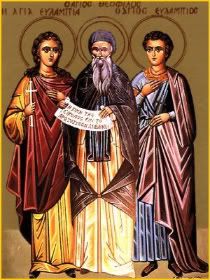 Folks, today, is the 27 Sunday in Ordinary Time, so the Resurrection of Our Lord always takes precedence, but along with the Christian Sabbath, we remember the Holy Guardian Angels and St. Theophilus of Bulgaria and Constantinople, a Benedictine monk of the East who died during the persecutions ensuing the Iconoclastic or "Icon-Breaking" controversies in the 8th century. He is my chosen holy namesake.
Folks, today, is the 27 Sunday in Ordinary Time, so the Resurrection of Our Lord always takes precedence, but along with the Christian Sabbath, we remember the Holy Guardian Angels and St. Theophilus of Bulgaria and Constantinople, a Benedictine monk of the East who died during the persecutions ensuing the Iconoclastic or "Icon-Breaking" controversies in the 8th century. He is my chosen holy namesake.Latin sources are scarce on St. Theophilus. According to the Benedictine Encyclopedia, he was born in Bulgaria; died c. 750. Theophilus was a Benedictine monk in Asia Minor, who was beaten, imprisoned, and exiled by Emperor Leo the Isaurian for his opposition to the iconoclasts. The Latin Calendar has this to say:
Constantinópoli sancti Theóphili Monáchi, qui, pro defensióne sanctárum Imáginum a Leóne Isáurico saevíssime caesus et in exsílium pulsus, migrávit at Dóminum.The Greek and Slavic sources are more generous but they don't disagree on St. Theophilus' banishment and subsequent death in exile. Nor do they mention his monastic Benedictine affiliation. According to the Greek Orthodox Synaxarion:
St. Theophilus is important to me because it was to honor him that I assumed his name upon becoming an Oblate of St. Benedict. He's a saint for both East and West, a lover of Holy Icons and defender of the Incarnation of Christ. Appropriately, and unbeknown to me until recently, his feast day falls one day after that of the Little Flower, whose name my wife assumed at her oblation. Together even in that! His feast day in the Eastern Calendar is observed on October 10 (October 23 in the Gregorian calendar).Saint Theophilus the Confessor of Bulgaria came from the area surrounding Tiberiada. When he was thirteen, the saint secretly left his home to go off to the monastery on Mount Selenteia. There he matured spiritually under the guidance of the Elder, St. Stephen. After three years St. Theophilus was tonsured into monasticism. When the parents of the saint learned where their son was, they went to the monastery and asked the igumen to send Theophilus and several of the brethren to establish a new monastery closer to the their home. The igumen bade all the monks to fast and to pray, so that a sign might be received. On the third day a voice was heard in the church giving the blessing for Theophilus to start a new monastery, since he would become reknowned for his many spiritual exploits. During the period of the iconoclast controversy culminating in the reign of the iniquitous iconoclast emperor, Leo the Isaurian (717-741), St. Theophilus openly revolted against the iconoclast folly. In accord with the emperor's orders, the saint was subjected to beatings and led through the city tied up like a criminal. The emperor then gave Theophilus over into the charge of the official, Hypatius who tried repeatedly to compel the confessor to renounce holy icons. Theophilus remained steadfast. Instead, he succeeded in converting Hypatius. As proof of the validity of icons, Theophilus cited the brass serpent erected by Moses (Num 21:9), the corroboration of the Cherubim atop the Ark of the Covenant, and finally how the Savior Himself had given to Abgar, the Prince of Edessa, His Icon Not Made by Hands (August 16). Persuaded by this evidence, Hypatius gained the emperor's permission to set the saint free. The confessor returned to his monastery. He lived only a short time longer, and in the year 716 St. Theophilus fell asleep peacefully in the Lord.
This St. Theophilus is my holy namesake.
- Thank you Kolokotronis, an Eastern Orthodox user on the Free Republic boards, for the Synaxarion's entry and St. Theophilus' Icon.